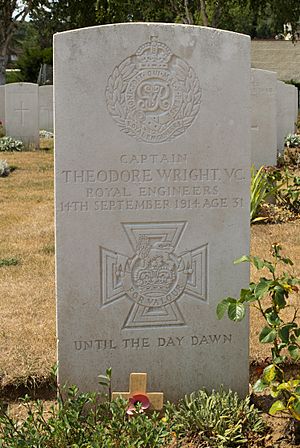Theodore Wright facts for kids
- This is about the British soldier; for others, see Theodore Wright (disambiguation).
Quick facts for kids
Theodore Wright
|
|
|---|---|
| Born | 15 May 1883 Brighton, East Sussex, England |
| Died | 14 September 1914 (aged 31) Vailly, France |
| Buried |
Vailly British Cemetery, Vailly, France
|
| Allegiance | |
| Service/ |
|
| Years of service | 1902–1914 |
| Rank | Captain |
| Unit | Royal Engineers |
| Battles/wars | World War I |
| Awards | Victoria Cross |
Captain Theodore Wright (born May 15, 1883 – died September 14, 1914) was a brave officer in the British Army. He received the Victoria Cross (VC), which is the highest award for courage a soldier can get in the British and Commonwealth forces. It is given for amazing bravery when facing the enemy.
Contents
Early Life and Military Career
Theodore Wright was born in May 1883 in a town called Brighton, England. He went to school at Clifton College. After that, he studied at the Royal Military Academy in Woolwich. This is where he trained to become an army officer.
On October 1, 1902, he officially joined the Royal Engineers. This part of the army focuses on building and engineering tasks. He started as a second lieutenant, which is a junior officer rank.
Heroic Actions in World War I
During the First World War, Theodore Wright was a Captain. He was 31 years old and part of the 57th Field Company of the Royal Engineers. He earned his Victoria Cross for incredible bravery.
Bravery at Mons
On August 23, 1914, a battle took place near Jemappes, Mons, in Belgium. A group of soldiers from the Royal Scots Fusiliers were holding a barricade. This barricade was at the north end of a bridge over the Mons-Condé canal. The fighting was very intense, and many soldiers were getting hurt. Because of this, the soldiers decided they needed to retreat.
Lance-Corporal Charles Jarvis, also from the Royal Engineers, was asked to destroy the bridge. However, he didn't have the right equipment to do it. He then met Captain Theodore Wright, who had been wounded in the head. Captain Wright told Jarvis to go back to the bridge. He promised to bring the equipment needed to blow it up.
Captain Wright tried to connect the wires under the bridge to make it explode. This was a very dangerous task. Each time he tried to lift his head above the towpath, enemy soldiers fired at him from only about 30 yards away. He kept trying, but it was too risky. Eventually, he had to give up. As he swung himself back under a part of the bridge, he lost his grip. He was very tired and fell into the canal. A Sergeant Smith helped pull him out. Lance-Corporal Jarvis also received the Victoria Cross for his part in this same brave action.
Final Act of Courage
Later, on September 14, 1914, Captain Wright was at Vailly, Aube, France. He was helping the 5th Cavalry Brigade cross a temporary bridge. While he was helping wounded soldiers find shelter, he was badly wounded himself. Sadly, he died from his injuries.
An officer who was there wrote a letter about Captain Wright. He said, "We got across the river the day before yesterday a bit before our time and we had to go back over a pontoon bridge considerably quicker than was pleasant, under a very heavy fire too. At the end of the bridge was an Engineer officer repairing bits blown off and putting down straw as cool as a cucumber – the finest thing I ever saw. The poor fellow was killed just after my troops got across. No man earned a better Victoria Cross."
The Victoria Cross Medal
Captain Theodore Wright's Victoria Cross medal is now on display. You can see it at the Royal Engineers Museum in Gillingham, Kent.


